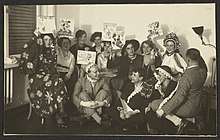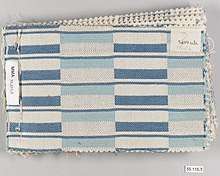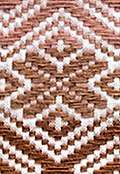Otti Berger
Otti Berger (4 October 1898 – 1944/45) was a textile artist and weaver. She was a student and later teacher at the Bauhaus.

Career
Berger was born in Zmajevac in Austro-Hungarian Empire (present-day Croatia). [1] She completed education at the Collegiate School for Girls in Vienna before enrolling in the Royal Academy of Arts and Crafts in Zagreb, now the Academy of Fine Arts, University of Zagreb. She continued her studies in Zagreb until 1926 before attending Bauhaus in Dessau, Germany.[2] There, Berger studied under László Moholy-Nagy, Paul Klee, and Wassily Kandinsky, among others. Berger has been described as "one of the most talented students at the weaving workshop in Dessau."[3]


A core member of the experimental approach to textiles at the Bauhaus,[5] Berger experimented with methodology and materials during the course of her studies at the Bauhaus to eventually include plastic textiles intended for mass production.[6] She applied for a patent for her textile designs which she called "Möbelstoff-Doppelgewebe" in 1932 and received it in 1934. She sold the rights to the Shriver Corporation.[7] Along with Anni Albers and Gunta Stölzl, Berger pushed back against the understanding of textiles as a feminine craft and utilized rhetoric used in photography and painting to describe her work.[5] During her time in Dessau, she also wrote a treatise on fabrics and the methodology of textile production, which stayed with Walter Gropius and was never published.[6]
Berger became a deputy to designer Lilly Reich in the textile workshop at Bauhaus. She began to create her own curriculum, and acted as a mentor to younger Bauhaus students who carried on Bauhaus methods, including Paris-based weaver Zsuzsa Markos-Ney and Etel Fodor-Mittag, who became a hand weaver in South Africa.[6][2] After spending a year teaching workshops under Lilly Reich, she opened up her own studio "otti berger atelier für textilien" in 1932. She went on to work with a number of firms and developed and designed a number of fabrics. She applied to patent three of her inventions and received patents for two of those.[7] Berger is the only designer from Bauhaus who sought patents for her textiles.[1]
Not allowed to work in Germany under Nazi rule because of her Jewish roots, Berger closed her company down in 1936. Berger fled to London, where attempts to emigrate to United States to work with her fiancee Ludwig Hilberseimer and other Bauhaus professors failed.[8][2] She wrote to László Moholy-Nagy, Naum Gabo, Walter Gropius, and other friends trying to gain a teaching visa in 1937 but never acquired one.[7] Berger was unable to find steady work in London, in part because she did not speak the language, but also because she had impaired hearing, and no social circle.[2] Berger returned to Zmajevac in 1938 to help her family with her mother's poor health.[2] From there, she was deported with her family to the Auschwitz concentration camp in April 1944, where she was murdered.[1]
See also
References
- "Otti Berger – Croatian Artist from the Bauhaus Textile Workshop | Bauhaus Online". bauhaus-online.de. Retrieved March 4, 2016.
- "Otti Berger | Bauhaus Online". bauhaus-online.de. Retrieved March 4, 2016.
- Weibel, Peter. Beyond Art: A Third Culture. A Comparative Study in Cultures, Art and Science in 20th Century Austria and Hungary. Vienna: Springer-Verlag, 2005. p. 76
- "Otti Berger. Book. The Met". www.metmuseum.org. Retrieved February 15, 2019.
- T’ai Smith. Bauhaus Weaving Theory: From Feminine Craft to Mode of Design. Minneapolis: University of Minnesota Press, 2014. Project MUSE. Web. June 13, 2015. https://muse.jhu.edu.
- Weibel, Peter. Beyond Art: A Third Culture. A Comparative Study in Cultures, Art and Science in 20th Century Austria and Hungary. Vienna: Springer-Verlag, 2005.
- Smith, T'ai (2008). "Anonymous Textiles, Patented Domains: The Invention (and Death) of an Author". Art Journal. 67 (2): 54–73. doi:10.1080/00043249.2008.10791304. ISSN 0004-3249.
- Fischer, Linn. "Otti (Otilija Ester) Berger. 1898 – 1944." Aviva: Online Magazin fuer Frauen. Berlin: 2015.
External links
| Wikimedia Commons has media related to Otti Berger. |
- Otti Berger entry at the Art Institute of Chicago
- Otti Berger entry at Bauhaus Online
- Artwork by Otti Berger at the Metropolitan Museum of Art
- Biography and works at Baunet
- Photograph "Party at Otti Berger's" at the Getty Center
- Otti Berger research and related links on Aviva
